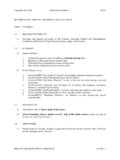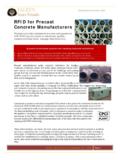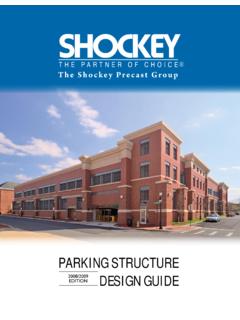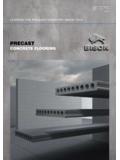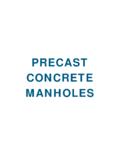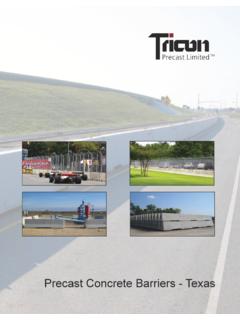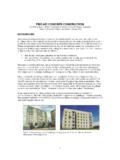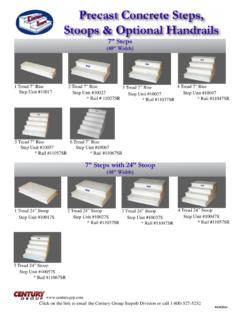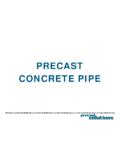Transcription of Architectural Precast Concrete Finishes Guide - APA
1 Architectural Precast Concrete Finishes Guide I. EXPOSED AGGREGATE - CHEMICALLY RETARDED AND SANDBLASTED Definition - This finish is achieved by casting against a form surface that has been painted with retarder which retards the set of the Concrete at its surface. After the panel is removed from the form, the retarder is removed by sandblasting. The end result is a panel with coarse aggregate exposed to the degree called for by the design. A. Reason for Use 1. Sandblasting achieves an exposed aggregate finish as easily as possible. 2. Sandblasting allows for the correction of many variations in exposure.
2 This method will achieve a more uniform surface. B. Positive Features 1. This method will achieve a more uniform exposure of stone aggregate with minimum effort. 2. Minor form imperfections do not impair the final surface. 3. This method will achieve a more uniform surface. 4. The variation in color choices are endless. C. Limitations 1. Any portion of the panel poured in a vertical position will not show the same concentration or positioning of aggregate as the flat surface. (This problem might be corrected by sequential casting which allows all surfaces to be cast flat.)
3 D. Expectations 1. Color consistency is dependent on the consistency of the aggregate. 2. Consistency of surface can be controlled reasonably well. 3. Sandblasting will mute the finish and color of the aggregate to a degree, depending on the hardness of the aggregate. 4. If a strong durable aggregate is used, the color and texture of this surface would not change over the years. E. Summary This finish should be used where the beauty of the aggregate or a textured surface is to be featured. The end result is a matte type finish, as opposed to a brighter finish achieved with waterwashing.
4 II. EXPOSED AGGREGATE - CHEMICALLY RETARDED AND WATERWASHED Definition - This finish is achieved by the application of a chemical retarder to the surface of the form. The retarder prevents the matrix from hardening at the surface of the panel to a specific depth, controlled by the strength of the retarder. After curing (normally overnight), the unhardened layer of matrix at the surface of the panel is removed by a high pressure waterwashing, thus, exposing the aggregate used in the Concrete . A. Reasons for Use 1. Exposed Aggregate displays the natural beauty of the stone aggregate in its natural colors and finish without damage.
5 2. It is an economical finish to achieve. B. Positive Features 1. The aggregate is not damaged or changed in this cleaning method. 2. Minor imperfections in the form do not affect the final product. 3. This finish is relatively easy to patch. 4. This finish tends to distribute water run off more evenly, thus reducing the streaking which appears on smooth surfaces. 5. The variation in color choices is endless. C. Limitations 1. The end result of chemical retardation removed by waterwashing is controlled by the retarder. Therefore, any variations in the exposure are not as correctable as in sandblasting.
6 2. Vertical, radius or complicated surfaces are difficult to cast with uniformity because the retarder is subject to movement during casting on these surfaces and variation in etch can result. 3. Waterwashing can be a seasonal activity for some producers in Northern climates. D. Expectations 1. This finish will display the aggregate in its natural beauty. 2. Control of mix, slump, retarder and the time of exposure is essential since there is very little correction allowed with the waterwashing method. Some variation will occur. Therefore, this should be minimized by having as little contrast between matrix and aggregate as possible.
7 E. Summary If the bright, natural colors of the aggregate are the prime concern, waterwashing is the best way to achieve this result. III. EXPOSED AGGREGATE - SANDBLASTED Definition - This finish is achieved by casting Concrete against a smooth hard surface. After removal from the form, the finished surface is sandblasted to remove the matrix and expose, as well as etch, the coarse aggregate. The depth of the blast is determined by the desired texture and the target color, as influenced by the color of the matrix and the coarse aggregate. The three different types of exposures are: Light Exposure - the surface skin of cement and sand is removed just sufficiently to expose the surface of the coarse aggregate.
8 Medium Exposure - a further removal of the matrix exposes approximately the same area of both coarse aggregate and matrix. Deep Exposure - cement and fine aggregate are removed to a depth where the coarse aggregate becomes the dominant surface feature. A. Reasons for Use 1. Sandblasted finish can be used to achieve textured surfaces in which the coarse aggregate is exposed, as well as etched by the blasting. B. Positive Features 1. Combining aggregate size and color and matrix color with texture from the blasting provides flexibility for the final finish. 2. Textured surfaces tend to distribute water run off more evenly, thus reducing streaking from normal weathering patterns.
9 3. Textured surfaces tend to forgive minor surface imperfections when observed at normal viewing distances. 4. Damage is more easily repaired on textured surfaces than on smooth Finishes . 5. The surface of the coarse aggregate is etched at the same time that it is being exposed by the blasting operation. C. Limitations 1. Sandblasting hardened Concrete is time consuming and expensive. The deeper the blasting, the higher the cost. 2. Damage to sandblasted surfaces, while easier to repair than smooth surfaces, is more difficult to repair than chemically retarded surfaces.
10 3. Air voids and uniformity of the aggregate density are difficult to control on vertical and sloped returns. 4. Soft aggregates tend to erode at the same rate as the matrix and sometimes cannot be used. 5. The exposure is influenced by the size of the sandblast sand and the skill of the sandblasting technician. Operating techniques must remain the same throughout the project to insure uniformity. D. Expectations 1. Good color uniformity can be achieved if care is taken in selection of the raw materials which contribute to the color of the product. Contrasting matrix and coarse aggregate colors should be avoided if uniformity of color is desired.
